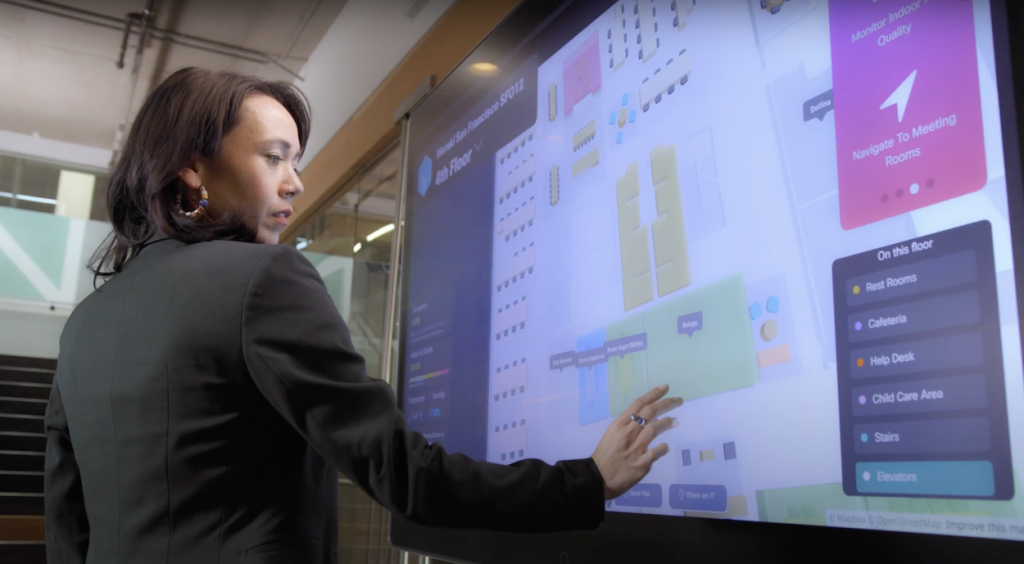
In the modern workplace, smart office technology has become a game-changer, revolutionizing how we work and collaborate. By integrating cutting-edge tools and intelligent features, it creates an efficient, connected, and adaptive work environment. Let’s explore the key components, standout benefits, and must-have tools for transforming your office into a smarter space.
What Is Smart Office Technology?
Smart office technology refers to the integration of connected devices, data-driven analytics, and automated systems designed to enhance workplace efficiency and employee wellbeing. By leveraging technologies like IoT, AI, and cloud computing, it enables businesses to create smarter, more adaptive workspaces. These solutions optimize operations through intelligent resource management, seamless communication, and energy efficiency. Additionally, they improve employee experiences by offering personalized, ergonomic, and collaborative environments tailored to modern workplace needs.
Smart Office Technology & Tools
Wi-Fi Connectivity
Wi-Fi connectivity is the backbone of smart office technology, enabling seamless real-time data flow between devices, applications, and cloud platforms. High-speed, low-latency connections ensure that all smart systems remain interconnected for efficient operations and instant communication. Advanced Wi-Fi standards like Wi-Fi 6 and Wi-Fi 7 provide reliable performance even in high-density office environments. This helps to support a large number of devices simultaneously without disruptions. This ensures consistent speed, security, and scalability for modern workplaces.
Internet of Things (IoT) Devices
IoT devices play a crucial role in collecting and exchanging data to enable real-time office management. These devices provide actionable insights, allowing businesses to automate tasks like adjusting temperature, lighting, or ventilation based on occupancy patterns. Such automation improves space utilization, enhances employee comfort, and boosts energy efficiency by eliminating waste. By seamlessly integrating IoT solutions, smart offices become more adaptive and sustainable.
AI-Driven Software
AI-driven software processes data from IoT devices to deliver predictive analytics and automate tasks such as room bookings, temperature adjustments, and workflow optimizations. By analyzing patterns and preferences, AI helps operations teams to proactively address needs before they arise. Additionally, it helps personalize the employee experience by customizing workspace settings, such as lighting and heating. This level of automation and personalization enhances employee satisfaction and drives overall productivity in the workplace.
Cloud-Based Platforms
Cloud-based platforms serve as centralized systems for managing IoT devices and AI systems. They offer real-time data insights and remote access to office technologies. These platforms enable businesses to monitor and control smart office systems from anywhere, ensuring seamless communication and efficiency. Solutions like Cisco Spaces integrate multiple systems into a unified interface, streamlining workplace management. By harnessing cloud platforms, organizations can make data-driven decisions to optimize operations and enhance employee experiences.
Key Features of Smart Office Spaces
Cisco Spaces offers a plethora of advanced features that extend beyond mere connectivity, fostering smart office spaces that are adaptive, efficient, and conducive to productivity. These features enhance workplace functionality, experience and employee satisfaction.
Desk & Meeting Room Management
Smart desking by Cisco Spaces enables employees to easily locate and reserve desks based on availability, location, and specific needs. Meeting room management is seamlessly integrated on digital maps, allowing employees to locate and book rooms in real-time. It also comes with filters for capacity and available collaboration tools, ensuring the right space for every requirement. This system is particularly beneficial for hybrid work models, offering employees the flexibility to book desks or meeting rooms for their in-office days. By optimizing space utilization and streamlining resource management, it supports smooth transitions between remote and in-office work, enhancing both convenience and productivity.
Environmental Monitoring & Climate Control Systems
It integrates IoT sensors to monitor critical environmental factors such as temperature, humidity, air quality, and lighting in real time. By leveraging occupancy data and user preferences, the system can automatically adjust HVAC and lighting to maintain comfort while optimizing energy efficiency and promoting sustainability. These intelligent adjustments ensure workplaces remain comfortable and healthy, aligning with employee needs and environmental goals. The result is a dynamic office environment that seamlessly adapts to changing conditions, fostering employee wellbeing and enhancing overall productivity.
Space Utilization Analytics
Cisco Spaces provides real-time data on space usage, including occupancy monitoring, to help businesses identify underutilized areas and make informed decisions about space planning. By analyzing trends in how office spaces are used, organizations can optimize layouts, reduce wasted space, and improve overall efficiency. Space utilization analytics enable employers to gain insights into employee behavior and preferences, allowing them to design workplaces that cater to actual usage patterns. This data-driven approach ensures smarter resource allocation, enhancing both functionality and cost-effectiveness in the modern office environment.
Wayfinding & Navigation
Cisco Spaces enables real-time indoor navigation to help employees and visitors effortlessly locate meeting rooms, desks, and essential amenities within a building. Using interactive AI-powered, 3D maps, the system provides precise guidance to destinations, eliminating the need for extra apps or physical signage. This streamlined wayfinding feature enhances the employee experience by saving time and reducing frustration when searching for points of interest. Additionally, it supports efficient space utilization and fosters smoother workplace flow, creating a more organized and productive office environment.
Asset Tracking
It also enables real-time asset tracking by leveraging Wi-Fi, IoT sensors and BLE tags to monitor and manage valuable equipment across the workplace. High-value items such as laptops, projectors, and other critical assets can be tracked and located through a centralized platform, ensuring efficient usage and minimizing the risk of loss or theft. This streamlined approach allows organizations to maintain a secure and well-organized workplace while reducing the effort and time required for manual inventory checks. Asset tracking enhances operational efficiency, enabling businesses to optimize their resources and safeguard key equipment seamlessly.
Integrated Workplace Management Systems
Cisco Spaces acts as a centralized platform that unifies various smart office technologies, including space management, environmental controls, and security monitoring. This integration enables facility managers to gain a comprehensive view of office operations, offering real-time insights into space utilization, occupancy trends, and environmental conditions. The cloud-based nature of the platform ensures scalability, ease of deployment, and accessibility from any location, making it a flexible and adaptable solution for modern workspaces. By providing a holistic view and streamlined management, Cisco Spaces empowers organizations to optimize their operational efficiency and enhance the overall workplace experience.
Benefits of Smart Office Technology
Boosted Productivity
Smart office technology enhances productivity by enabling faster workflows, minimizing distractions, and automating routine tasks, allowing employees to focus on high-priority work and improve output. Features like smart desking and real-time space availability monitoring simplify daily processes, ensuring employees can quickly find and reserve the resources they need. This streamlining promotes better time management, enabling teams to work more efficiently and effectively. By removing barriers to productivity, these tools create an environment where employees can thrive and deliver their best results.
Reduced Costs
Smart office systems reduce operational costs by incorporating energy efficient environmental controls and optimizing space usage, which minimizes energy waste and reduces carbon footprint. By providing real-time insights, these systems enable employers to make data-driven decisions that reduce unnecessary expenses. Additionally, cloud-based platforms eliminate the need for costly hardware investments, offering a scalable, cost-effective solution that adapts to the organization’s growth. This combination of efficiency and flexibility helps businesses control costs while maintaining a modern, functional workspace.
Enhanced Employee Experience
Personalized and adaptive work environments enhance employee satisfaction by providing flexibility in workspace choices, improving comfort, and fostering a positive workplace atmosphere. Tools like indoor navigation and meeting room finder ensure a seamless workday, enabling employees to locate what they need quickly and focus on their tasks. This convenience and adaptability empower employees, increasing their engagement and morale. By prioritizing employee needs, these smart office technologies create a more productive and fulfilling work experience.
Improved Decision Making
Real-time and historical data analytics on occupancy and space usage empower real estate planners and facilities managers to make informed decisions about workspace optimization and resource allocation. By analyzing trends and patterns, employers can identify inefficiencies and implement targeted improvements that align with organizational goals. Access to up-to-date information allows companies to stay agile, quickly responding to evolving needs and challenges. This proactive approach ensures that decision-making is both strategic and adaptable, driving greater efficiency and long-term success.
Optimized Energy Efficiency
Smart office systems help businesses meet sustainability goals by reducing energy consumption, improving resource efficiency, and supporting eco-friendly practices. Automation in areas such as lighting and temperature control ensures energy is used only when necessary, cutting down on waste and lowering utility costs. These systems monitor and adjust in real-time, promoting sustainable practices within the workplace. By integrating these technologies, companies can achieve significant energy savings while contributing positively to the environment.
Implementing Smart Office Technology & How Cisco Spaces Makes it Easy
Implementing smart office technology involves assessing office needs, selecting appropriate solutions, and ensuring seamless installation and integration with existing systems. Cisco Spaces streamlines this process by offering a comprehensive platform with plug-and-play capabilities, intuitive management tools, and real-time analytics, making the transition effortless and efficient for businesses.
1. Assess Office Needs & Existing Systems
The first step in implementing smart office technology is to conduct a thorough assessment of office needs. This includes evaluating current workspace utilization, understanding employee preferences, and aligning with operational goals. Businesses should analyze factors such as space efficiency, employee productivity, and the demand for advanced features like environmental control, asset management, and collaboration tools. This comprehensive evaluation helps identify areas for improvement and ensures that the chosen technology solutions address specific organizational requirements effectively.
2. Plan & Budget a Smart Office Design
Careful planning and budgeting are crucial for a successful smart office implementation. This stage involves identifying the technologies to be used, setting realistic budget goals, and mapping out the project’s scope. Clear objectives must be established, such as enhancing employee experience, reducing operational costs, or achieving sustainability goals. By aligning the project plan with these objectives, businesses can ensure the smart office design meets their specific needs and delivers measurable benefits.
3. Choose the Right Technology
Choosing the right technology is essential to ensure the smart office system aligns with an organization’s specific goals and delivers maximum value. Businesses should evaluate factors such as device compatibility, ease of integration with existing systems, robust security features, and the ability to scale as needs evolve. Cisco Spaces simplifies this process by integrating seamlessly with existing Cisco network infrastructure, such as Catalyst and Meraki, offering a future-proof solution that ensures maximum returns on network investments. Additionally, Cisco Spaces supports a wide range of IoT devices from over 50 pre-integrated vendors, ensuring smooth integration with both Cisco and third-party IoT systems for a cohesive and scalable smart office environment.
4. Proper Installation of Hardware & Software
Proper installation is critical to ensure that all smart office systems function seamlessly together. This involves following best practices, such as correctly configuring IoT sensors, networking equipment, and software to avoid integration issues and ensure optimal performance. Businesses must also verify that devices are strategically placed for maximum efficiency and connectivity. Cisco Spaces simplifies this process with tools like AP auto location, enabling quick and hassle-free deployment without the need for complex installations.
5. Train Employees on Smart Technology
Employee training is essential to ensure staff can effectively utilize and benefit from smart office systems. Training should focus on key functionalities such as room booking, space reservation, environmental control, and how to interact with workplace features through mobile apps or desktop platforms. This empowers employees to take full advantage of the technology, improving productivity and enhancing their workplace experience.
6. Continue to Adapt to New Advanced Technology
Implementing a smart office is an ongoing process that needs to evolve and align with evolving business needs and employee feedback. Regular monitoring of system performance, gathering user feedback, and updating technologies help identify areas for optimization and ensure sustained efficiency. With Cisco Spaces, this adaptation is simplified — the platform is designed to evolve, scale and integrate with emerging technologies, allowing for seamless updates without the need for costly or disruptive overhauls. This ensures organizations remain agile and ready to adopt future advancements in workplace technology.
Transform Your Workplace with Cisco Spaces
Smart office technology is revolutionizing the way workplaces function, offering businesses the ability to optimize office space, enhance employee productivity, and improve operational efficiency. Cisco Spaces empowers organizations by leveraging their existing Cisco infrastructure to turn physical buildings into intelligent, smart spaces. With features like real-time occupancy and environmental monitoring, indoor navigation, and advanced analytics, businesses can create efficient, comfortable, and energy-saving smart workplaces tailored to their needs.
Cisco Spaces is a future-proof, flexible platform that integrates seamlessly with existing Cisco networking hardware and IoT devices such as sensors, BLE beacons, and third-party systems. This ensures smooth deployment and scalability as workplace needs evolve. The platform also offers innovative features like interactive 3D maps, intuitive smart room controls, and actionable insights to improve space utilization and drive impactful business outcomes.
Discover how Cisco Spaces can transform your workplace. Explore live demonstrations, curated user journeys, and hands-on tools to experience the power of smart office technology firsthand.


